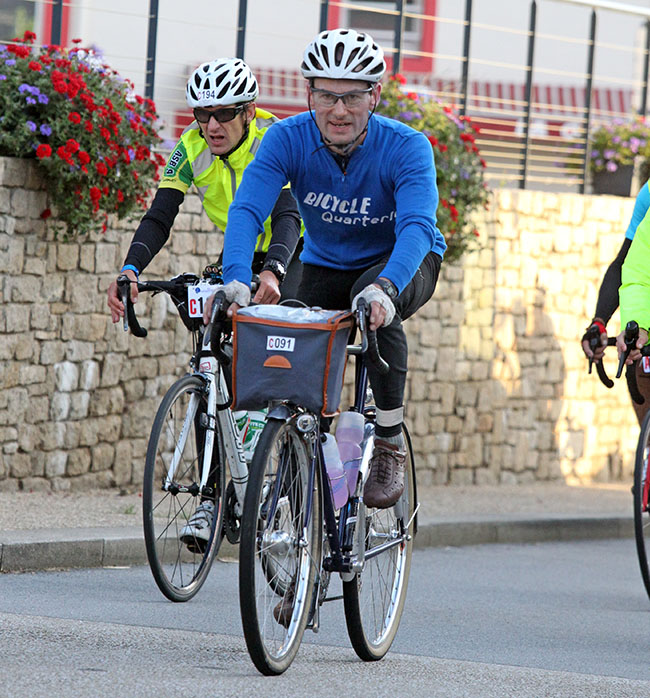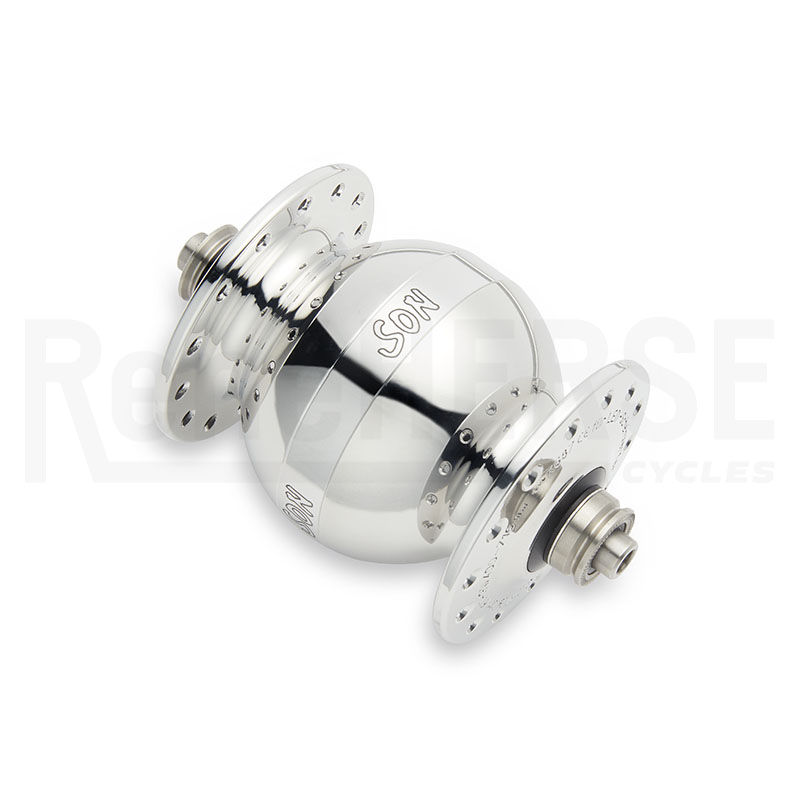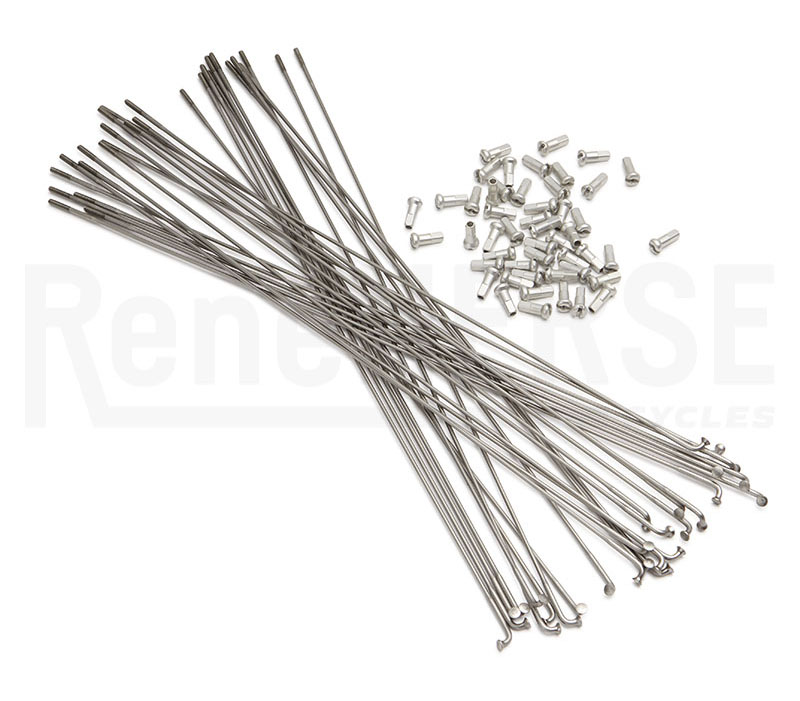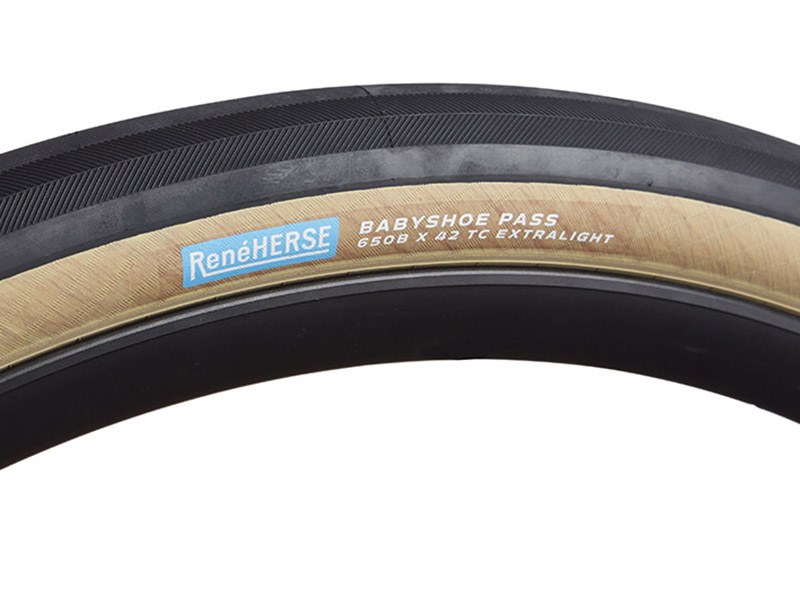My PBP Bike: The Wheels

When I asked which part of my bike for last summer’s Paris-Brest-Paris our readers wanted to hear more about, the answer was: “Everything.” So I’m writing a series of posts about the parts of the bike. I’ve already talked about the frame and the centerpull brakes. Today let’s look at the wheels.
When thinking about the wheels for my new bike, I started with the tires I wanted to run, since everything follows from that. It was tempting to go with a really huge tire, like our 54 mm Rat Trap Pass. Our testing indicates that they don’t roll any slower, but there are other compromises when your tires get wider than about 44 mm. It’s harder to fit a rim brake around them. Fenders with good coverage start interfering with the chain. Really wide tires can be more sensitive to tire pressure, and their huge supple sidewalls tend to get deflected more on road cambers.
For a bike that gets ridden mostly on pavement, over huge distances and often at night, 42-44 mm-wide tires seem like the perfect compromise. From that followed that my new bike would have 650B wheels. Why not 700C? I like a nimble feel to my bike – not quite as eager to turn as a racing bike, but almost. Wider tires inevitably are heavier, so it makes sense to reduce the wheel size to keep the rotational inertia the same. With 700C x 42 mm tires, unless you mount them on superlight and super-expensive carbon rims, the bike tends to be too stable for my taste. It becomes too hard to change my line in mid-corner, for example, in a decreasing-radius turn or if a pothole suddenly appears in my path. Conversely, 26″ wheels will not hold their line in corners as well as I’d like.
The old myth that 700C wheels roll faster also has been disproven many times now. Whether it’s pavement or gravel, small variations in wheel size don’t affect how fast a wheel rolls. All that makes 650B the Goldilocks wheel size for 42 mm tires – just right.
Next I had to select my hubs. On the front, the choice was easy: The SON generator hubs have proven themselves over millions of miles. They have a clever pressure compensation system that keeps moisture out of the bearings – the main cause for the premature demise of lesser generator hubs. The Delux model has the least resistance of all generator hubs, and the Wide-Body puts the flanges as far outward as possible. That results in a stronger wheel, allowing me to use fewer and thinner spokes without getting too much deflection when I climb out of the saddle. I’ve found that 28 spokes are plenty on a rim brake front wheel (which has zero dish), as long as you run wide tires that cushion the blows on the wheel.

For the rear hub, I would have liked to use a modern hub, but I haven’t found one that I like. The hub bearings on my Firefly are rough after just 4,000 km (2,500 miles). Another popular brand on a test bike had the tiny 2.5 mm Allen that holds the bearing adjustment come loose – apparently a common issue. I know many riders have good experiences with these and other hubs, but I went with what has been working well for me on many bikes. I didn’t choose Maxi-Car hubs because they are ‘retro’ or ‘classic,’ but because they’ve been working so well for me.
Maxi-Car hubs go for decades without needing overhauls or adjustment. The bearings are protected by double labyrinth seals, so the grease doesn’t get contaminated. The axles are oversized, so they don’t break. The bad part is that they aren’t made any more, and they’re only available for freewheels. Fortunately, I was able to find a brand-new 13-26 Dura-Ace 7-speed freewheel to go with my hub, giving me plenty of gears.
I chose a 36-hole hub because only that model has keyhole spokeholes on the drive side. It’s a brilliant feature, allowing spoke replacement without pulling the freewheel/cassette. If a spoke breaks, you unscrew the old spoke, hook the head of the new spoke into the keyhole, and screw on the nipple. Replacing a spoke on the road takes less than 3 minutes. Admittedly, that’s less of an advantage these days, as spokes rarely break when you run wide tires that cushion the blows on the wheel, but still… Another nice feature: The spokes on both sides are the same length – if you look carefully, you can see that the keyholes don’t space the spokes evenly, but in a way that they are a tad longer than they’d usually be – making them the same length as on the non-drive side. Not having to carry two different spoke lengths is nice…
Thirty-six spokes is a lot – 32 would be sufficient. But there’s no real disadvantage to those extra four spokes: The rear wheel is in turbulent air anyhow, so the aerodynamics aren’t a big deal. And with less load on each spoke, I can use aluminum nipples, which more than makes up for the weight of the extra spokes.
Speaking of spokes, I used Sapim Laser spokes. These beauties are butted with 2.0 mm ends and super-thin 1.5 mm center sections. That means they stretch more, so they are less likely to go slack when I hit a bump, which can loosen a spoke and also fatigues them prematurely. Spokes are a perfect example where less material makes them last longer. At the ends, where spokes tend to break if they do, the Lasers measure a 2.0 mm, making them strong. And the 1.5 mm center sections also make the wheel more aerodynamic and less affected by cross-winds. Of course, they are little lighter, too. The only downside is that ultra-thin spokes tend to wind up more when you build the wheel. It’s not difficult to compensate for that: You turn the nipple a little further and then back off to unwind the spoke. You can feel how far the spoke has wound up – it’s very smooth since nothing is turning – and you stop backing off when you feel the spoke turning in the nipple.
Compared to the spokes I used in the past, Sapim spokes are super-nice. The butted ends are short, because they are made specially for each length, so you get the fullest advantage of the butting. The heads are perfectly formed, so these spokes are less likely to break. I never thought I’d get excited about spokes…
In the past, finding spokes in the right lengths required many phone calls, because no local shop has all lengths in stock. Rene Herse Cycles now stocks the spokes you need to build wheels with the generator hubs and rims we sell. I was lucky – one of the sizes we stock also works for my rear wheel.
For the rims, I chose Pacenti’s Brevet model. It’s the first ‘modern classic’ rim that isn’t suffering from cracking and/or overly deep wells.
I was also tempted by the HED Belgium Plus – they are a little lighter and maybe more aero – but they don’t come with 36 holes for my rear wheel. It’s nice to have two great 650B rim options.
I run Rene Herse Extralight tires on all my bikes for their speed and comfort. I inflate my Babyshoe Pass 650B x 42s to about 35 psi (2.4 bar) for paved rides. For rough gravel, I drop the pressure down into the mid-20s (1.7 bar). I usually run tubes – Schwalbe’s SV14A are superlight, hold their pressure for a long time, and have zero issues with splitting sidewalls, poorly vulcanized valves and other issues that can affect budget tubes.

So far, I’m totally happy with my choice of wheels. I haven’t had to touch them yet: They’ve remained true after many hard rides on pavement and gravel, and the tires haven’t had a flat yet. (Touch wood!) And every time I tackle a fast corner with a decreasing radius, the bike adjusts its line with ease, while the wide tires grip tenaciously. It brings a smile on my face.
Other parts of this series:






